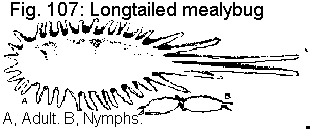 Fig. 107: Longtailed
mealybug,Pseudococcus longispinus (Targioni-Tozzetti),
Pseudococcidae, HOMOPTERA
Fig. 107: Longtailed
mealybug,Pseudococcus longispinus (Targioni-Tozzetti),
Pseudococcidae, HOMOPTERA Return to: MREC Home Page
Return to: Index
DESCRIPTION Adult Female- Up to 3 mm
long, female longtailed mealybugs have 17 pairs of waxy filaments
around the periphery. On mature specimens, the caudal (tail)
filaments are as long as or longer than the yellowish to grayish
body (unless the tail filaments have broken off). Overall length
maybe 6 to 7 mm. Egg- There is no external egg stage of the
longtailed mealybug. Nymphs- The nymph is similar to the larger
adult female except that the filaments around the edges are
shorter.
 Fig. 107: Longtailed
mealybug,Pseudococcus longispinus (Targioni-Tozzetti),
Pseudococcidae, HOMOPTERA
Fig. 107: Longtailed
mealybug,Pseudococcus longispinus (Targioni-Tozzetti),
Pseudococcidae, HOMOPTERA
Longtailed mealybug. A, Adult. B, Nymphs. ![]() ZOOM
ZOOM
BIOLOGY
Distribution-Longtailed mealybugs appear to be cosmopolitan in tropical and subtropical environments. In temperate zones, they survive in greenhouses or homes throughout the world. Host Plants- Longtailed mealybugs have been found on at least 26 plant families. Dracaena appears to be the favored host, but most flowering and ornamental foliage plants are susceptible. Damage- Longtailed mealybugs feed by sucking out plant sap from leaves and stems. Honeydew and sooty mold further disfigure infested plants, which may eventually be killed. These pests also secrete a fluffy white wax which also detracts from the appearance of infested plants. Life History- Although longtailed mealybugs were first described in 1867, not much has been published on their biology. Females give birth to live young on a shallow pile of white waxy secretions. Because the females are wingless, they must be brought into proximity of a host plant before it can be infested. A small wasp, Anagyrus nigricornis, parasitizes longtailed mealybugs, and a small, predaceous, brown lacewing insect feeds on them. Ants sometimes protect longtailed mealybugs from parasites and predators and feed upon the honeydew excreted by these mealybugs.
CONTROL
Brown and green lacewings exert some biological control of these mealybugs. Longtailed mealybugs are sometimes difficult to control, even though there is no egg stage protected by a dense ovisac. If many plants are infested, they should be dipped or sprayed thoroughly with a pesticide mixture or the entire greenhouse treated with an aerosol. It is best to retreat two or more times at weekly intervals. Retreatment will control mealybugs that were missed by earlier control efforts. For specific chemical control recommendations, see the current Cooperative Extension publications on ornamental plant pest management or consult your county Extension agent.
Reference to University of Florida/IFAS Pest Control Guides